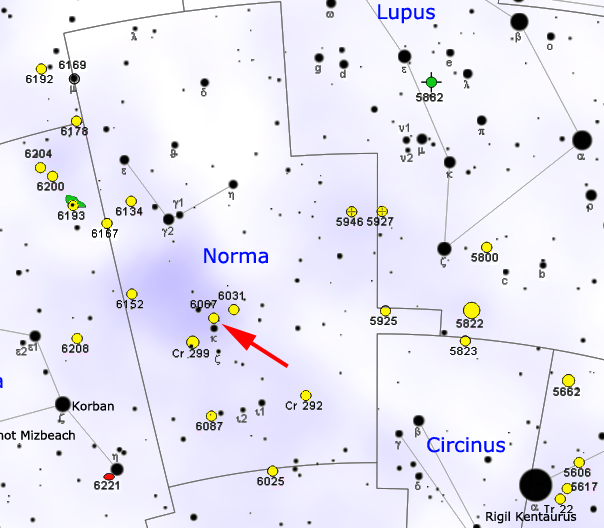|
NGC 6067
NGC 6067 is an open star cluster, open cluster in the constellation Norma (constellation), Norma. It is located to the north of Kappa Normae, with an angular diameter of 12. Visible to the naked eye in dark skies, it is best observed with binoculars or a small telescope, and a 12-inch aperture telescope will reveal about 250 stars. Discovered by James Dunlop in 1826, it has been described by John Herschel as "a most superbly rich and large cluster" and by Stephen James O'Meara as "one of the sky's most stunning open star clusters". Its brightest stars have an apparent magnitude of around 8. There are 84 member stars with an apparent magnitude brighter than 12. NGC 6067 is located in the Norma Star Cloud in the Norma Arm of the Milky Way and is 15 to 20 times as rich as the Pleiades and about the same age. It is thought to be around 102 million years old, and contain 893 solar masses. Two Cepheid variables, QZ Normae and V340 Normae, have been identified as members of the cluster, ... [...More Info...] [...Related Items...] OR: [Wikipedia] [Google] [Baidu] |
J2000
In astronomy, an epoch or reference epoch is a moment in time used as a reference point for some time-varying astronomical quantity. It is useful for the celestial coordinates or orbital elements of a celestial body, as they are subject to perturbations and vary with time. These time-varying astronomical quantities might include, for example, the mean longitude or mean anomaly of a body, the node of its orbit relative to a reference plane, the direction of the apogee or aphelion of its orbit, or the size of the major axis of its orbit. The main use of astronomical quantities specified in this way is to calculate other relevant parameters of motion, in order to predict future positions and velocities. The applied tools of the disciplines of celestial mechanics or its subfield orbital mechanics (for predicting orbital paths and positions for bodies in motion under the gravitational effects of other bodies) can be used to generate an ephemeris, a table of values giving ... [...More Info...] [...Related Items...] OR: [Wikipedia] [Google] [Baidu] |
Milky Way
The Milky Way or Milky Way Galaxy is the galaxy that includes the Solar System, with the name describing the #Appearance, galaxy's appearance from Earth: a hazy band of light seen in the night sky formed from stars in other arms of the galaxy, which are so far away that they cannot be individually distinguished by the naked eye. The Milky Way is a barred spiral galaxy with a Galaxy#Isophotal diameter, D25 isophotal diameter estimated at , but only about 1,000 light-years thick at the spiral arms (more at the bulge). Recent simulations suggest that a dark matter area, also containing some visible stars, may extend up to a diameter of almost 2 million light-years (613 kpc). The Milky Way has several List of Milky Way's satellite galaxies, satellite galaxies and is part of the Local Group of galaxies, forming part of the Virgo Supercluster which is itself a component of the Laniakea Supercluster. It is estimated to contain 100–400 billion stars and at least that number of pla ... [...More Info...] [...Related Items...] OR: [Wikipedia] [Google] [Baidu] |
Open Clusters
An open cluster is a type of star cluster made of tens to a few thousand stars that were formed from the same giant molecular cloud and have roughly the same age. More than 1,100 open clusters have been discovered within the Milky Way galaxy, and many more are thought to exist. Each one is loosely bound by mutual gravitational attraction and becomes disrupted by close encounters with other clusters and clouds of gas as they orbit the Galactic Center. This can result in a loss of cluster members through internal close encounters and a dispersion into the main body of the galaxy. Open clusters generally survive for a few hundred million years, with the most massive ones surviving for a few billion years. In contrast, the more massive globular clusters of stars exert a stronger gravitational attraction on their members, and can survive for longer. Open clusters have been found only in spiral and irregular galaxies, in which active star formation is occurring. Young open clusters may ... [...More Info...] [...Related Items...] OR: [Wikipedia] [Google] [Baidu] |
Centre De Données Astronomiques De Strasbourg
Center or centre may refer to: Mathematics *Center (geometry), the middle of an object * Center (algebra), used in various contexts ** Center (group theory) ** Center (ring theory) * Graph center, the set of all vertices of minimum eccentricity * Central tendency, measures of the central tendency (center) in a set of data Places United States * Centre, Alabama * Center, Colorado * Center, Georgia * Center, Indiana * Center, Warrick County, Indiana * Center, Kentucky * Center, Missouri * Center, Nebraska * Center, North Dakota * Centre County, Pennsylvania * Center, Portland, Oregon * Center, Texas * Center, Washington * Center, Outagamie County, Wisconsin * Center, Rock County, Wisconsin **Center (community), Wisconsin *Center Township (other) *Centre Township (other) *Centre Avenue (other) *Center Hill (other) Other countries * Centre region, Hainaut, Belgium * Centre Region, Burkina Faso * Centre Region (Cameroon) * Cen ... [...More Info...] [...Related Items...] OR: [Wikipedia] [Google] [Baidu] |
Globular Cluster
A globular cluster is a spheroidal conglomeration of stars that is bound together by gravity, with a higher concentration of stars towards its center. It can contain anywhere from tens of thousands to many millions of member stars, all orbiting in a stable, compact formation. Globular clusters are similar in form to dwarf spheroidal galaxy, dwarf spheroidal galaxies, and though globular clusters were long held to be the more luminous of the two, discoveries of outliers had made the distinction between the two less clear by the early 21st century. Their name is derived from Latin (small sphere). Globular clusters are occasionally known simply as "globulars". Although one globular cluster, Omega Centauri, was observed in antiquity and long thought to be a star, recognition of the clusters' true nature came with the advent of telescopes in the 17th century. In early telescopic observations, globular clusters appeared as fuzzy blobs, leading French astronomer Charles Messier to incl ... [...More Info...] [...Related Items...] OR: [Wikipedia] [Google] [Baidu] |
Open Cluster
An open cluster is a type of star cluster made of tens to a few thousand stars that were formed from the same giant molecular cloud and have roughly the same age. More than 1,100 open clusters have been discovered within the Milky Way galaxy, and many more are thought to exist. Each one is loosely bound by mutual gravity, gravitational attraction and becomes disrupted by close encounters with other clusters and clouds of gas as they orbit the Galactic Center. This can result in a loss of cluster members through internal close encounters and a dispersion into the main body of the galaxy. Open clusters generally survive for a few hundred million years, with the most massive ones surviving for a few billion years. In contrast, the more massive globular clusters of stars exert a stronger gravitational attraction on their members, and can survive for longer. Open clusters have been found only in spiral galaxy, spiral and irregular galaxy, irregular galaxies, in which active star formatio ... [...More Info...] [...Related Items...] OR: [Wikipedia] [Google] [Baidu] |
Planetary Nebula
A planetary nebula is a type of emission nebula consisting of an expanding, glowing shell of ionized gas ejected from red giant stars late in their lives. The term "planetary nebula" is a misnomer because they are unrelated to planets. The term originates from the planet-like round shape of these nebulae observed by astronomers through early telescopes. The first usage may have occurred during the 1780s with the English astronomer William Herschel who described these nebulae as resembling planets; however, as early as January 1779, the French astronomer Antoine Darquier de Pellepoix described in his observations of the Ring Nebula, "very dim but perfectly outlined; it is as large as Jupiter and resembles a fading planet". Though the modern interpretation is different, the old term is still used. All planetary nebulae form at the end of the life of a star of intermediate mass, about 1-8 solar masses. It is expected that the Sun will form a planetary nebula at the end of i ... [...More Info...] [...Related Items...] OR: [Wikipedia] [Google] [Baidu] |
American Association Of Variable Star Observers
The American Association of Variable Star Observers (AAVSO) is an international nonprofit organization. Founded in 1911, the organization focuses on coordinating, analyzing, publishing, and archiving variable star observations made largely by amateur astronomers. The AAVSO creates records that establish light curves depicting the variation in brightness of a star over time. The AAVSO makes these records available to professional astronomers, researchers, and educators. Professional astronomers do not have the resources to monitor every variable star. Hence, astronomy is one of the few sciences where amateurs can make significant contributions to research. In 2011, the 100th year of the AAVSO's existence, the twenty-millionth variable star observation was received into their database. The AAVSO International Database (AID) has stored over thirty-five million observations as of 2019. The organization receives nearly 1,000,000 observations annually from an estimated amount of 2,00 ... [...More Info...] [...Related Items...] OR: [Wikipedia] [Google] [Baidu] |
V340 Normae
V34, or similar, may refer to: * Brazilian corvette ''Barroso'' (V34) * ITU-T V.34, a modem standard * Fokker V.34, a German prototype fighter aircraft of World War I {{Letter-NumberCombDisambig ... [...More Info...] [...Related Items...] OR: [Wikipedia] [Google] [Baidu] |
QZ Normae
QZ may refer to: * Indonesia AirAsia, a low-cost airline (IATA:QZ; founded 1999) * Quartz, a crystalline mineral (IMA:Qz) * Quartz (publication), ''Quartz'' (publication), a business news ezine (at qz.com; launched 2012) * QZ decomposition of matrices, in linear algebra See also * QS (other) * ZQ (other) {{Disambiguation ... [...More Info...] [...Related Items...] OR: [Wikipedia] [Google] [Baidu] |
Cepheid Variable
A Cepheid variable () is a type of variable star that pulsates radially, varying in both diameter and temperature. It changes in brightness, with a well-defined stable period (typically 1–100 days) and amplitude. Cepheids are important cosmic benchmarks for scaling galactic and extragalactic distances; a strong direct relationship exists between a Cepheid variable's luminosity and its pulsation period. This characteristic of classical Cepheids was discovered in 1908 by Henrietta Swan Leavitt after studying thousands of variable stars in the Magellanic Clouds. The discovery establishes the ''true luminosity'' of a Cepheid by observing its pulsation period. This in turn gives the distance to the star by comparing its known luminosity to its observed brightness, calibrated by directly observing the parallax distance to the closest Cepheids such as RS Puppis and Polaris. Cepheids change brightness due to the κ–mechanism, which occurs when opacity in a star increases wit ... [...More Info...] [...Related Items...] OR: [Wikipedia] [Google] [Baidu] |







